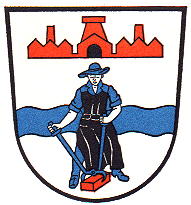Hüttental: Difference between revisions
Jump to navigation
Jump to search
Knorrepoes (talk | contribs) m (Text replacement - "{{de}}" to "") |
Knorrepoes (talk | contribs) m (Text replacement - "{| class="wikitable"↵|+Official blazon↵|-↵|'''German'''↵| ↵|-↵|'''English''' ↵| {{blazon wanted}}↵|}" to "{| class="wikitable" |+Official blazon |- |'''German''' | blazon wanted |- |'''English''' | blazon wanted |}") |
||
| Line 14: | Line 14: | ||
|- | |- | ||
|'''German''' | |'''German''' | ||
| | | blazon wanted | ||
|- | |- | ||
|'''English''' | |'''English''' | ||
| | | blazon wanted | ||
|} | |} | ||
Revision as of 08:14, 6 April 2023
HÜTTENTAL
State : Nordrhein-Westfalen
District (Kreis) : Siegen-Wittgenstein (until 1975 Siegen)
Additions : 1966 Amt Weidenau, Birlenbach, Buchen, Dillnhütten, Geisweid, Langenholdinghausen, Meiswinkel, Niedersetzen, Obersetzen, Sohlbach, Weidenau (1937 Buschgotthardshütten (partly))
Incorporated into : 1975 Siegen
| German | blazon wanted |
| English | blazon wanted |
Origin/meaning
The arms were granted in 1968 and combine elements from the arms of the former municipalities.
The upper half is derived from the arms of Weidenau, the lower from Geisweid. The arms as a whole are partly canting (Hütte=factory) and symbolise the importance of heavy industry for the municipality.
Literature: Stadler, 1964-1971, 8 volumes.
